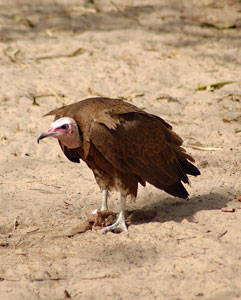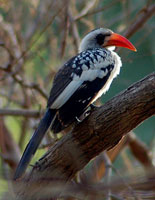![]()
Karinti (Tanjii River) Bird Reserve
![]()
 Established in 1993, Tanji River Bird Reserve
(in the area known locally as Karinti), together with Bijol Islands is situated along the
Atlantic Coast, in the Western Division, Kombo North, about 30 minutes drive from the
tourist development area. It encompasses the Tanji River and its estuary, incorporating
mangrove, dry woodland and coastal dune scrub woodland. It has a total area of 612ha (6.12
square km). Along the seashore there a series of lagoons, and offshore at the Bijol
Islands which are an important site for breeding turtles and roosting birds.
Established in 1993, Tanji River Bird Reserve
(in the area known locally as Karinti), together with Bijol Islands is situated along the
Atlantic Coast, in the Western Division, Kombo North, about 30 minutes drive from the
tourist development area. It encompasses the Tanji River and its estuary, incorporating
mangrove, dry woodland and coastal dune scrub woodland. It has a total area of 612ha (6.12
square km). Along the seashore there a series of lagoons, and offshore at the Bijol
Islands which are an important site for breeding turtles and roosting birds.
Areas of Interest
Bald Cape is formed from a shallow reef of laterite rock which extends to the north west reappearing at the Bijol Islands 1.5km offshore. The Cape is backed by a lagoon which runs south into a broken chain as far as the village of Tanji. The lagoon system has developed from a combination of the outflow of the Tanji River and longshore drift accumulating sand deposits. It is a dynamic system and significant changes can result from a single flood or storm. The Cape and lagoons serve as a feeding and roosting grounds for a large diversity of gulls, terns and waders.
 The Tanji River rises near Yundum Airport 14km to the east of Tanji. It is tidal for
about 3km inland where the banks are lined mainly with the stilt-rooted red mangrove (Rhizophora
Racemosa) and backed by the smaller white mangrove (Avicennia Ntida) where the land is
flooded only during spring tides. Behind the mangrove fringe there are salt flats, where
the salinity is too high to support vegetation with the exception of a few hardy plants
such as the succulent Sesuvium Portulastrum. As the land rises to the east the
saline intrusion diminishes and the river takes on freshwater characteristics with water
lilies and other aquatic herbs choking the water course during the rainy season.
The Tanji River rises near Yundum Airport 14km to the east of Tanji. It is tidal for
about 3km inland where the banks are lined mainly with the stilt-rooted red mangrove (Rhizophora
Racemosa) and backed by the smaller white mangrove (Avicennia Ntida) where the land is
flooded only during spring tides. Behind the mangrove fringe there are salt flats, where
the salinity is too high to support vegetation with the exception of a few hardy plants
such as the succulent Sesuvium Portulastrum. As the land rises to the east the
saline intrusion diminishes and the river takes on freshwater characteristics with water
lilies and other aquatic herbs choking the water course during the rainy season.
Habitat Type - Coastal Dune Scrub Woodland
 Within the Tanji River Bird Reserve there is a wide variety of habitat types including
marine, estuarine, freshwater, coastal scrub woodland and dry woodland savannah. Coastal
dune scrub woodland extends along the seaward strip of the reserve to the west of the main
road. The diversity in structure reflects the past use of the area. The northern strip is
denser and of lower canopy height due to previous clearance. The southern strip is more
open with isolated mature trees due to long term grazing patterns. Dune scrub-woodland is
limited to areas of sand accumulation, conditions which pose problems for moisture and
nutrient availability. The dominant species found are the ginger bread plum (Parinari
Macrophylla), the rhun palm (Borassus Aethiopum) and the Baobab (Adansonia
Digitata). The understorey is generally grass dominated with the feathery flowered (Perotis
Indica) , the stiff leafed Sporobulus Spicatus and the spiny fruited Cenchrus
Biflorus.
Within the Tanji River Bird Reserve there is a wide variety of habitat types including
marine, estuarine, freshwater, coastal scrub woodland and dry woodland savannah. Coastal
dune scrub woodland extends along the seaward strip of the reserve to the west of the main
road. The diversity in structure reflects the past use of the area. The northern strip is
denser and of lower canopy height due to previous clearance. The southern strip is more
open with isolated mature trees due to long term grazing patterns. Dune scrub-woodland is
limited to areas of sand accumulation, conditions which pose problems for moisture and
nutrient availability. The dominant species found are the ginger bread plum (Parinari
Macrophylla), the rhun palm (Borassus Aethiopum) and the Baobab (Adansonia
Digitata). The understorey is generally grass dominated with the feathery flowered (Perotis
Indica) , the stiff leafed Sporobulus Spicatus and the spiny fruited Cenchrus
Biflorus.
Avi-Fauna
Tanji River Bird Reserve was established primarily for its ornithological importance which is evident from its current species list which totals 259 species from 61 different families, making it a paradise for birdwatchers. This large diversity of birds results from the range of habitats present combined with the location of Tanji on the coast of West Africa. For European migrants, Tanji is one of the first stop offs and offers both a safe haven as well as good feeding opportunities. The offshore Bijol Islands are used as a roosting site by large numbers of gulls, terns, waders and pelicans, and the shallow surrounding reef offers good feeding opportunities also. Thirty four species of Raptor (birds of prey) have been recorded from the reserve which reflects the abundance and diversity of prey.
Fauna
An impressive range of terrestrial mammals also occupy the area. They include Western Red Colobus, Callithrix Monkey and Patas Monkey, Genet, Civet, Hyena, Porcupine and Bushbuck. The surrounding waters are imporant feeding grounds for green turtle which breed on both the mainland and on the Bijol Islands. The internationally rare monk seal has also been seen there occasionally.
![]() Home-
Back to start page
Home-
Back to start page
![]()
E-mail mcamara @post3.tele.dk
Last updated on January 5th, 2019
![]()
[Me] [Africa] [Culture]
[Links][Bantaba]
[Guest book][The
Stone circles][Serrekunda]
The information on this page was provided by Department of Parks & Wildlife Management, The Gambia. For further information on visiting the protected areas of The Gambia contact the Ecotourism & Training Unit, PO Box 2164, Serrekunda, email wildlife@gamtel.gm